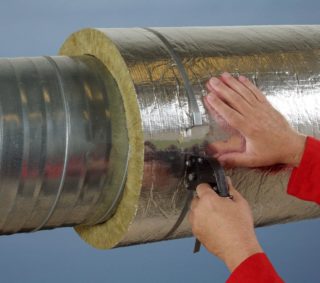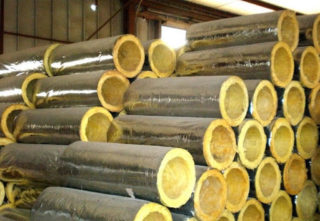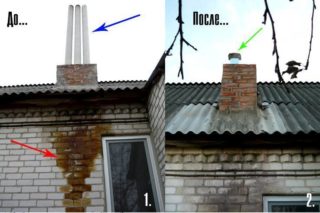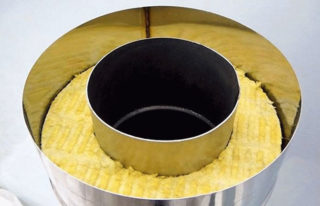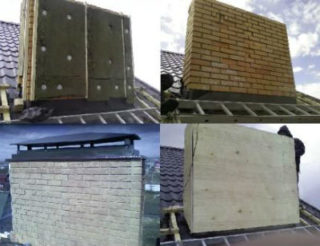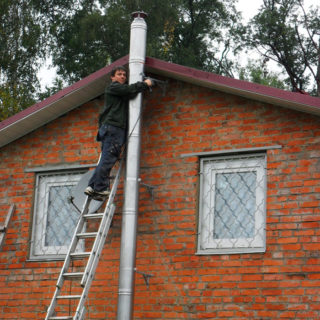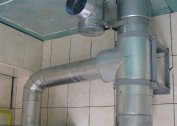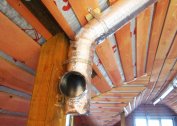As a rule, a gas or solid fuel boiler is installed to heat a private house in the cold season. A reliable and high-quality channel is required for the removal of combustion products. The design must be strong and durable so that it can serve throughout the life of the building. Thermal insulation of the chimney helps to achieve these goals, without the high cost of construction and subsequent maintenance. The modern market is saturated with heat insulators, differing in appearance, properties and technical characteristics. In order not to get confused in the variety of products offered, you should familiarize yourself with its features, installation rules, advantages and disadvantages.
The need and advantages of chimney pipe insulation
When building their own mansion, many landowners underestimate the role and importance of communications for the removal of gases released during the combustion of fuel. Leaving the pipe open to environmental impact, they risk losing property and their own lives.
An insulated chimney pipe is a necessity justified by the following factors:
- The pipe is very cooled in the winter cold. Its heating takes a large amount of energy, which entails a decrease in the temperature of the coolant and increased fuel consumption.
- The difference between the internal and external temperature of the pipe walls leads to the formation of condensate. When mixed with smoke, a caustic substance forms, which even corrodes stainless steel.
- On the moisture formed in the channel, solid particles of combustion products settle, which leads to the appearance of solid deposits. The draft deteriorates, the risk of a complete clogging of the pipe and smoke in the room where the boiler is installed increases.
- The dew point is low, as the gases leaving the furnace quickly cool. The insulated chimney does not have a dew point per se, because its temperature is the same throughout, and the inner walls do not come in contact with cold air.
- The most vulnerable are brick channels. Moisture is absorbed into the brick, and when frozen, it breaks the material, causing a slow but steady destruction of the entire structure.
If immediately after the construction the chimney is insulated, the productivity of the furnace will increase and the safety of the inhabitants of the house will increase.
Materials for insulation
Fuel consumption, work efficiency, and the service life of the structure largely depend on the correct choice of thermal insulation.
The material must meet the following qualities:
- low thermal conductivity;
- light weight;
- water resistance;
- fire resistance;
- ecological cleanliness;
- the possibility of arranging with your own hands.
You should not pay attention to the price, since first of all, reliability and durability are given priority.
To insulate the chimney pipe, the following materials and technologies are used:
- Plaster. Facade mixtures are selected that are equally resistant to heat, cold and humidity. Plaster is used for decorating canals of brick and stone. The solution is superimposed on a reinforcing cage from a mesh or lattice. This technique is characterized by high labor costs and low efficiency. It is rarely used, for the most part to create a unified style of courtyard buildings.
- Expanded clay.An analogue is broken red brick and crushed slag. Initially, a casing is made of metal, plastic or waterproof plasterboard. Then the material is poured into the casing and compacted. The downside is that the filler absorbs moisture and gradually settles under its own weight, while losing its insulating qualities.
- Mineral wool. Modern, ideal in all respects heat-insulating material, suitable for finishing pipes of any configuration and composition. Mats, rolls and ready-made cylinders (shells) are used. The best indicators are basalt wool made from dolomite rocks. The insulation is screwed, glued or wrapped around the pipe, and then closed by an external protective screen. A prerequisite for installing mineral wool is the use of a membrane film to remove moisture.
When choosing material for insulation, it is necessary to objectively assess your skills and the amount of work. It may be necessary to involve an assistant in order to comply with the technology and safety measures during the performance of complex manipulations.
The design of the insulated chimney and its features
Regardless of the type of boiler, it is necessary to insulate the chimney. In final form, this design consists of such parts:
- Channel to remove smoke. It is an internal part that can have a round, square and rectangular section. It is made of materials that withstand the intense heat that occurs during the combustion of fuel. Throughout, the inner shell may have a different composition, but must maintain the same channel area.
- Outer shell. Designed to hold and protect the internal filling from the effects of natural factors - moisture, ultraviolet radiation, insects, birds and animals. As a rule, it is done in a form corresponding to the internal channel. The outer shell is fixed in such a way as to prevent the formation of cold bridges. At the same time, the casing should be made so that it does not spoil the appearance of the house, but organically complements it with its design.
- Insulation layer. Serves to create a thermal barrier between the inner channel and the outer shell. On the one hand, the filler prevents overheating of structures in contact with the chimney. On the other hand, the internal channel does not come in contact with the cold air of the street. Thanks to this, the pipe does not cool down, the draft improves, condensation and soot formation are excluded.
By their design, chimneys are divided into internal and external.
In the first case, the pipe runs vertically along the entire height of the building through the floor slabs, attic and roof. This option is good in that there are no angles or bends along the channel. Such facilities are characterized by high-quality traction, ease of cleaning and preventative maintenance. The downside is that you have to make holes in the supporting structures and perform complex waterproofing work. Thermal insulation issues are decided depending on the type of heating in the house. If there is a water circuit in living rooms, it is better to isolate the pipe, leaving it open in the attic to ensure its heating. When there are solid fuel stoves in the building, it is better to use a hot pipe as one of the elements of the heating system and heating water for domestic purposes.
If you lay the chimney outside, you can save time and effort on the passage of floors. However, such pipes require better insulation, as they will be exposed to cold and moisture. The downside is that in order to bring the canal out onto the street along its length, you will have to make turns, which negatively affects traction. The solution is to use curved inserts or connecting bends with a bend angle of not more than 45 degrees.
Warming methods for different types of construction
Each type of chimney has its own insulation technologies and a choice of insulation materials.
- Asbestos-cement pipes. The substance has a slight hygroscopicity, but it is also sufficient for the pipe to suffer from changes in temperature. The asbestos canal conducts heat well, it is best to seal it with mineral wool, close it with wider stainless steel pipes from above. The minimum distance between the walls should be 6 cm. Assembly is carried out from the bottom up. After installation, the sections are filled with insulation, then fastened with bolts or rivets. Joints are sealed with sealant, and a cement plug is made on top to protect against moisture.
- Steel structures. It should be borne in mind that the iron chimney has high thermal conductivity and transfers all the heat from burning fuel. You can insulate the metal pipe of the chimney with your own hands by plastering it or by enclosing it in a cocoon of tin and mineral wool. In the first case, a fiberglass mesh is wrapped around the channel, over which a solution is applied. If necessary, the procedure is repeated several times until the desired effect is achieved. Making sandwich sections is more expensive and time-consuming, but this method is much more practical. Trumpets are made at the ends of the pipes, after which the narrow fragments are wrapped with insulation, and wider billets are tightly pressed over it.
- Brick chimneys. It is advisable to insulate the chimney pipe on the street in a private house immediately after drying the masonry. The material is porous, absorbs moisture, mold, moss and even grass quickly appear on it. The best option is a combined approach. First, the brick is coated on the outside with a heat-resistant cement-based mortar. Then the frame is made of a metal profile. Mineral wool mats are inserted inside, and a membrane film is attached over the frame. The final step is to cover the frame with a profiled sheet. The material is beautiful, strong and durable.
Knowing how to choose and insulate the chimney correctly, you can easily and easily carry out this work yourself.
DIY chimney insulation
It is recommended to engage in measures for thermal insulation of the chimney in the warm season, during dry and calm weather. Such conditions are necessary to minimize the likelihood of injury.
To work, you will need such tools, fixtures and materials:
- puncher, screwdriver;
- level, tape measure;
- hammer, hacksaw, riveter;
- trowel, putty knife, paint brush;
- safety equipment, helmet, safety glasses and gloves, gauze bandage or respirator;
- chimney sweep.
The list may be larger or smaller, depending on the material of the chimney and the technology chosen.
The insulation process consists of the following steps:
- Design. A detailed diagram is drawn up indicating all distances, parts, methods of fastening and connections. Based on the drawing, the calculation of building materials is done, and a step-by-step work plan is also outlined.
- Preparatory phase. A workplace is equipped, the availability and serviceability of equipment is checked, the condition of safety equipment is checked.
- Cleaning the chimney from pollution and soot. First you need to clean the channel from soot. After insulation, the temperature in the pipe rises, which can lead to fire and fire. Then it is necessary to clean the outer surface of unstable fragments, dirt and vegetation.
- Pipe processing. The metal is coated with an anti-corrosion agent, asbestos cement and brick are coated with a deep penetration primer, which strengthens the material and protects it from moisture swelling.
- Insulation installation.It can be inserted into the frame, glued, screwed on or simply wrapped with subsequent fixation with screeds or wire.
- Mounting the outer casing. The choice depends on the shape and material of the pipe. After fixing, the ends and joints are sealed.
- Finishing and cleaning the remaining construction waste.
Even in an insulated chimney soot forms. It should be inspected and cleaned quarterly if more than 2 mm soot is formed on the inner walls.
